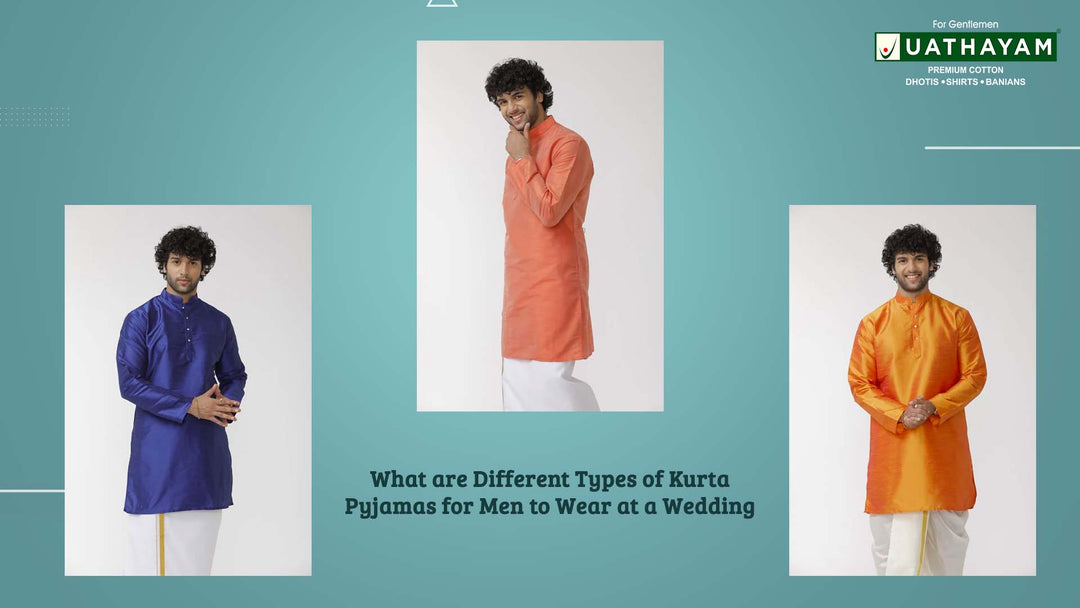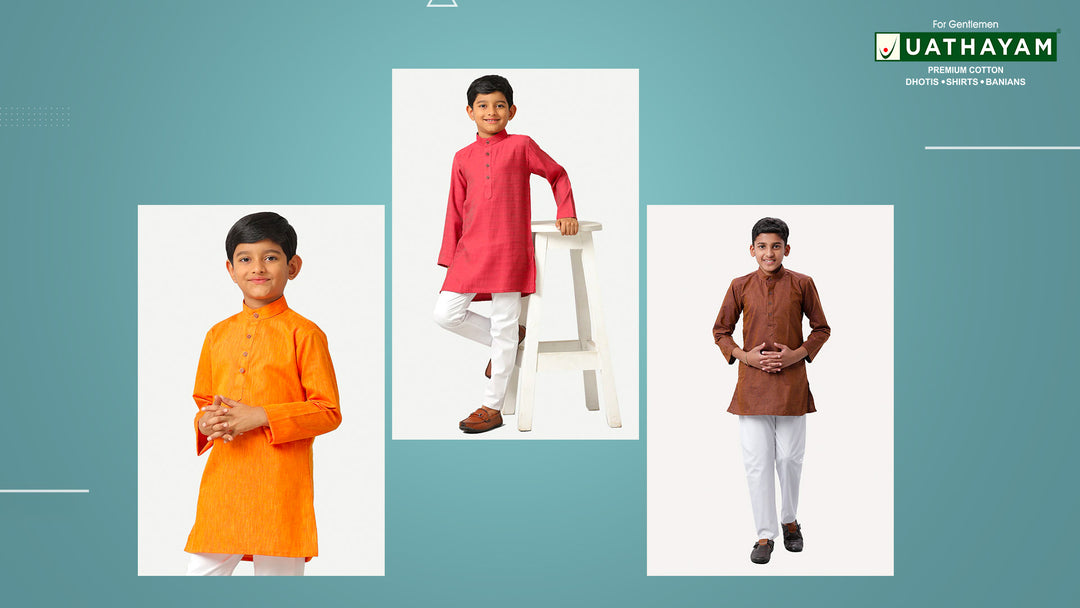Veshti - A classic that never goes out of style
Among the most traditional and ancient styles that men can wear, the veshti is among the most stylish. It is undoubtedly an iconic part of Indian culture and has certainly gained much attention lately. Fashionable and trendy yet deeply rooted in south Indian culture.
It is one such men's garment that offers a glimpse of the sartorial traditions of South India. The pure white and unstitched garment was worn in both rituals and regular use. Silks were reserved for ceremonies and special occasions, while cotton was preferred for everyday wear.
The simple white Dhoti was always the dress of the ordinary people, woven without any embellishment. Working-class men wore veshtis with a shorter length and a few pleats on the front. The brahmins wore the Veshti as a Panchakachham, which has five tucking’s and is draped in kacham style. It is most commonly worn around the waist. It is tucked toward the right side of the abdomen by most communities, especially Hindus.

Know Everything about Veshti or Dhoti
Veshti is a word that originated from the Sanskrit word Dhauta. Initially, it was worn only with a kurta. It was also considered an attire that commanded respect and dignity. It is available predominantly in white and cream colours. The material for this fabric is cotton. In most regions of the south, it is mainly made using a gold border. A total of five knots are used to wrap this garment.
Usually, it is worn during a festival or a marriage ceremony. Especially in most south Indian weddings, it is an integral part of men's wear. Almost every politician wear this as their formal wear.
How to wear the Veshti/Dhoti
Here is the simplest and fastest method to learn how to wear:
- The first step is to start by folding it in half to half its original length.
- Wrap it around your body. The stripes should be vertical and held by the left hand at the top.
- Hold it behind you and wrap one side around your body. Fold the side you wrapped around.
- The veshti can be typically worn at knee level to increase flexibility and ventilation. Begin by bending over and grabbing one end of it or bending your knee and bringing it to you. Next, pull the other side up and loosely tie the ends together.
As there is no right or wrong way to wear a Dhoti, you can get creative and tie it up however you like. For added convenience, some now have pockets and belts.

Different types of Veshtis
In India, the veshti is a piece of unstitched cloth worn by wrapping it around your legs and pulling the lower part of it inside the waist wrap from the back. Pleats are formed on the front side of the Dhoti after it is tucked in, resulting in two separate pieces for each leg, much like loose trousers.
A simple drape such as the Otte Veshti or single veshti is usually four Muzham or 3.7 m long. Rettai Veshti (Double veshti) is also sometimes used in formal functions. Since Rettai Veshti texture is thinner, wearing two layers is comfortable.
Depending on the occasion, it is typically worn with a shirt, a kurta, a jacket, or almost all men's tops. Also, the footwear you can wear with a dhoti depends on the occasion. You can wear leather chappals, kolhapuri chappals, or traditional Indian shoes, such as juttis or mojaris.
Best Wedding styles with Dhotis
The versatility of a veshti is ideal for weddings, formal occasions, and traditional attire! Whether it has a simple zari border or a grand Mayilkann border, this garment compliment a man's traditional dress. For weddings and special occasions, the most popular style is pairing a traditional cotton one with an Anga-vastram.
Anga-vastram is a garment worn on the upper part of the body. Men usually fold it up to knee level and tuck it in front so that their legs can move freely.
The casual elegance and comfort of a traditional cotton veshti are unmatched. For any special occasion, this classic ensemble will cast a lasting charm.
Venpattu, also called Pattu Veshti, is a silk veshti adorned by the groom at Tamil weddings; it symbolizes purity and goodness.
Veshti With Zari Embroidered Shirt
Pair up our cotton Veshti with one of our Zari embroidered shirts to wear at weddings or social occasions.

Prince Coat on Veshti
This beautiful combination of Dhoti with a matching prince jacket is perfect for any festive occasion. Looks elegant and is bound to make a statement and bound to make heads turn
Kurta and Dhoti
The combination of these two is unbeatable. Whether you wear it for special occasions or a regular basis, the kurta and veshti are a perfect match. Possibly the most versatile way to wear a Dhoti, this combination will never disappoint.
Formal Shirt on a Veshti
A traditional and classy way of wearing the traditional cotton veshti paired with a crisp formal cotton shirt. Traditionally, it is worn regularly in south Indian culture and during religious ceremonies and functions.
Different styles of wearing Dhotis
Despite how simple this clothing looks, Indians have created complex ways to style it, with a bit of colour and sophistication.
They can be worn formally and casually by men, and both styles can be wrapped differently, depending on the occasion. It is wrapped firmly around the legs for a more casual everyday look. Back of the Dhoti is pulled down to the front and tucked at the waist, followed by tucking the loose ends at the back, which creates a form of loose-fitting trousers. In the case of formal veshti style, it is tucked in at the back and flows into long pleats at the front, covering the legs loosely.
How a Malayali wears the Mundu
Kerala is a state in South India where men mostly wear the glorious Mundu. A thick border lining is the Kara which usually lines the Mundu. Kara comes in a variety of colours and sizes. There are double-coloured and ornamental Karas (a strip of colour at the end of the mundu). For more formal occasions, a Mundu has golden embroidery known as Kasavu (like weddings). The wearer highlights the Kara by carefully folding the end of the Mundu
Veshti, the pride of Tamilnadu
As previously mentioned, Veshti, like many wrap clothes, varies in style. Wrapped around the waist, it is secured by tucking a corner underneath. This is the Veshti in Tamil style. Contrary to a dhoti, it is worn as a Sarong rather than looped around the legs. Veshti with a shirt makes it a very elegant ensemble
Wearing Dhotis, the North Indian way
Veshti, which is called dhoti in North India, is made of rectangular pieces of unstitched cloth wrapped around the waist and legs and then knotted either at the front or back to form a firmly fitted trouser-like garment that wraps around both legs. Formal wear includes silk dhotis with embroidered borders.
Why People in India love Veshtis
A traditional Dhoti is simple yet elegant and stylish at the same time. It gives the wearer an air of nobility and classic flair. The piece of clothing has stood the test of time, and Indian men still wear it for social gatherings, religious ceremonies, and festivals, especially in the south. It goes very well with a kurta, a formal shirt, or bandhgala jacket. This garment is a key part of the wedding ceremony, especially for grooms.
Foreigners love it too
Foreign tourists are encouraged to shop for these beautiful clothes online or at local shops. It has withstood the test of time, when it is very easy to be swept away by the wave of modern attires and grooming
Tips for buying perfect Veshtis online
Although you can buy veshtis sitting comfortably at home with the power of the Internet, finding the right men's veshti within your budget and material can still be a daunting task.
- Consider the intended use of the garment you are about to purchase. Whether you want to buy a casual veshti that can be worn with different outfits for a variety of occasions, or you want a designer dhoti for special occasions.
- If you are new to wearing it, make sure to opt for a readymade veshti that will allow you the ease of wearing it. The readymade men's veshti is very simple to use and hardly takes any time to wear. On the other hand wearing a traditional veshti will need some practice.
- Choose the cloth material according to your comfort level and durability while choosing. A high-quality garment can last very long if properly cared for.
- It would be best if you kept an eye on sales as then you can easily find hidden gems at low prices.
What is the current fashion trend with dhotis?
The current fashion trend with dhotis has evolved from the traditional long piece of cloth wrapped around the waist and tied at either end to the availability of readymade options. Minister White offers a wide range of dhotis for men, designed for various occasions and purposes. These include pure silk dhotis, Kerala Colour dhotis, Velcro dhotis, pocket dhotis, festive dhotis, wedding cream Cotton dhotis, and panchakacham dhotis. This diversity in styles allows individuals to embrace the fashion trend of dhotis while also catering to their specific needs and preferences.
If the search for a perfect traditional veshti was fruitless, you didn't search at the right place. Head over to Uathayam, which offers a wide range of traditional veshtis and shirts for men and kids for all occasions.





